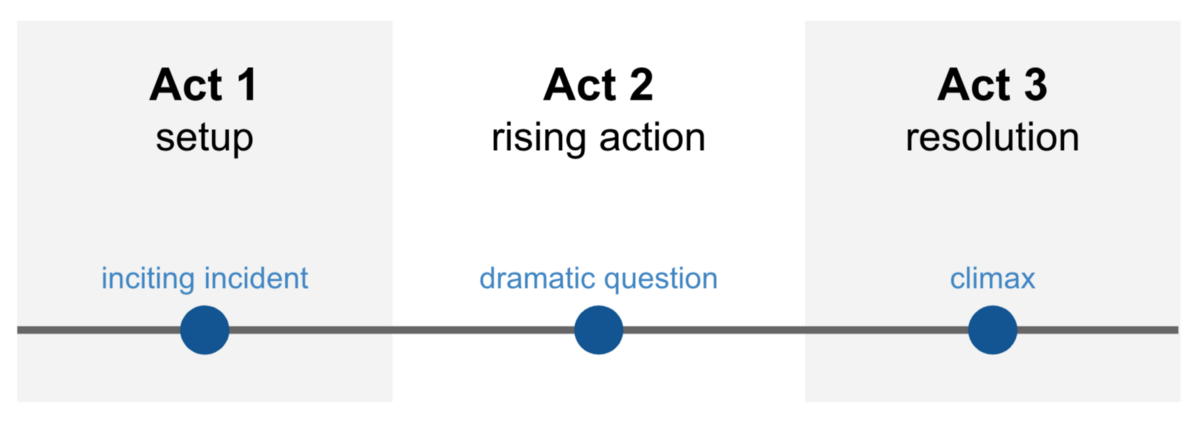The power of storytelling in business & PR (or, How to make people fall in love)
With your business, not with each other. That would be creepy.
Think back over the past few years. What are the adverts you remember? What are the businesses? Which big, famous people stand out in your recollection?
Next, ask yourself why. Why those people, why those companies. What sets them apart from the literal millions of other little bursts of news and information that vied for your attention from every screen, magazine, and Insta-story you scrolled past.
The storming of the US Capitol. That ship that got wedged in the Suez Canal. Jeff Bezos and six of his favorite capitalists taking a luxury cruise into the cosmos. Pretty much anything Trump has ever said or done. NFTs. SpaceX. Elon Musk.
I guarantee the answer is that each one was wrapped up in a story that either surprised, appalled, or delighted you.

- Stories make up around 65% of our daily interactions
- We are 22 times more likely to remember a fact when it has been presented within a story
- We've been known to overspend by 132,000% on a trinket worth $1.49 when there's a captivating fictitious story attached to it
Put simply, storytelling in business works. Here's how it can work for you.
Storytelling for business is a little different from your regular, run-of-the-mill storybook-storytelling, most notably because the aim of pretty much all businesses, by definition, is to make people buy their stuff.
That immediately puts us at odds with conventional storytelling, which strives to affirm the nature of humanity and subtly imply that our lives have meaning. Wild, I know.
Fortunately, there are similarities, and you can absolutely borrow lessons from the storytelling playbook to benefit your business.
The first challenge with any story – and any piece of marketing material – is to make the person on the receiving end care about what you're showing them.
Of course, being fundamentally selfish beings (hey, don't look at me – it's fact), people only really care about the things that affect them. That's why it's so difficult to get us to donate money to the preservation of spiders and why we we tend to become more conservative in our politics as we get older.
The point being, there needs to be something in what you're pitching that your audience can identify with.
The simplest way to do that is to give them a character and a story.
Startups do this all the time.
That's because they have no money, a handful of clients, and often nothing beyond a flimsy proof of concept scrawled onto the back of a sauce-stained napkin to persuade others to invest actual money into their business.
Listen to any episode of The Pitch or turn over to Dragon's Den and pay attention to how the founders present their product. Very few will start with statistics or charts or a tagline. Instead, they'll say something like this. (The pitch starts two minutes in:)
What these people are doing is storytelling.
And it doesn't much differ from the storytelling structure you'll see all around you in the media, your kids' books, and the backs of juice cartons.

That's because people love stories! We're wired for it. You give someone a character and a problem, and they can't help but compulsively teleport into their shoes.
That makes storytelling an incredibly powerful tool for communication.
Speaking of tools, the best digital storytelling tools can lighten your load when crafting a narrative story that people actually care about.
In short? Stories…
- Are personal
- Allow people to connect with one another across boundaries
- Are more memorable than mere facts
- Show the humanity behind your business
- Build trust in your business
- Move the bottom line
I'll bet your day-to-day is chock full of opportunities for brand storytelling:
- Client case studies
- Your about page
- Blog posts, articles and other publications
- Social media
- Storytelling in business communications
- Face-to-face interactions with other humans
To tell a story that resonates, you need to know your audience. So, do your research.
Don't use language and content that implies you're better than other people – that doesn't make you popular at parties and it's not going to work here.
There needs to be a unity of tone across your entire business. Don't be rigid in your advertisements if your site is hilarious; don't be playful on social media if the rest of your messaging reads like the Magna Carta.
Whatever your story promises, you need to be able to deliver on that promise. You never want to be the boy who cried wolf.
Ready to tell your brand story?
Publish and share your stories with a completely free 14-day trial of Prezly to start to understand how people engage with your content – and which of your contacts are your biggest fans. No payment info required.

At this point I would be saying to myself, ok, you've made your point – so how can I be a better storyteller in business? While the following bits of advice aren't set in stone, they are points you should consider as you work on figuring out the storytelling strategy best suited to your business.
I'm going to skim over how to find your audience because we have a whole article about audience discovery as well as a whole hour-long interview on building a following with the master himself, Rand Fishkin.
All I will say is that before you can tell someone a story they'll care about, you need to know who you're speaking to. What are their hopes? Their fears? What do they deal with day to day? How do you fit into that picture?
MP dedicated every waking moment to battling an untouchable foe that tormented him every single day – even when it meant putting his family second.
His nemesis? The Sun.
Now it's time for one final strike against all odds.
Can MP overcome this celestial body and win back his high-school sweetheart and the respect of his children?
Tomorrow is the longest day of the year which means it’s the perfect day to get out there and launch a coordinated 17 hour attack against the sun who’s with me
Now, isn't that a far, far more entertaining example of a brand story, than an account that tweets "Buy Moonpies, half price!" two/three times a week on a rolling content schedule?
Pulling off a level of social media storytelling this immense is incredibly difficult. Not only do you need a super creative and on-the-ball social media manager on board, you need to have the confidence to give that person free reign, resources, and support – because this doesn't happen overnight.
Think it's frivolous and dumb? That's your prerogative. But hey, a lot of people care.
I hope that @MoonPie and Linda get back together someday.
You don't need to go all-in on social media if that doesn't fit with your wider company tone. There's no problem in being more conventional or serious so long as you know your audience.
In business storytelling, often the best person to tell your story is your customer, since they encompass both impartiality and proof of concept. They are immediately closer to winning the trust of your audience than someone whose interests are intrinsically linked with your company's – like, say, the CEO.
No wonder research conducted by content marketing agency Headstream in 2015 showed that the majority of people want to hear business stories about regular people, then about clients, and last of the pile, the company's founder.

However, there are times when having an internal member of the team doing the telling is a smart move.
Remember that when someone tells you a story that draws you in, you become personally connected to that person; you feel closer to them and you feel like you can trust them. That's why thousands upon thousands of businesses invest in making their CEO the "thoughtleader" of their organization. After all, if people like the CEO, they'll likely buy into the business – because it's so much more natural to subscribe to a person than a faceless corporation.
Here are a few ideas to help you decide who is the best person for your strategic storytelling.
- The origin story – told by the founder
- What makes your product life changing – told by the customer
- The impact of your business on the industry – an external party, e.g. a journalist
- Authenticity and one to trust – told by your employees, clients, community
- Your business disrupts the status quo – told via industry experts, big names
Every civilized human being is a skeptic. We mistrust what seems bright and shiny, asking, What's the catch?
What are YOU trying to sell ME?
There's always something beneath the surface, a subtext or desire masquerading behind whatever you're presenting to the world. It's one of the biggest conflicts in modern marketing – how do you be authentic in what you're putting out into the world when at the end of the month, the thing you're measured on is ROI?
“Everyone has a natural detector for psychological realism. We can tell when something rings false.”
– Raymond A. Mar, York University via Scientific American
A big part of this can be resolved by the previous point, that is, choosing the right person to tell your story. The founder of your company is likely to truly believe in its mission, while a customer whose life is better thanks to your product will be authentic in singing its praises.
Whatever you do, don't try to be too clever, or think that you can coerce the audience down a path because of something you made up. Instead, be vulnerable. Use your own experiences and the experiences of those around you to tell a story based on truth.
Desire is at the heart of all storytelling. Without desire, there's no reason for your main character – or your company, or your audience – to embark on their journey.
It's the core belief without which your company wouldn't exist.
Once you know your desire, you can start to figure out what's stopping you from achieving it. That's the big bad you have to overcome.
What you decide to do in the face of this huge antagonistic force is the thing that propels your story.
You can already see how that might be a problem when it comes to storytelling in business. It's easy to fight for something you personally believe in, but only the most dedicated employees will consider their company's goal their own raison d'etre. That's why founders are your first stop for company storytelling. Use them.
Make sure that everything you're saying leads to that singular goal.
Prezly – software for modern PR teams
Write & publish brand stories in an online newsroom
Send email campaigns, pitches & newsletters
Manage all your contacts in a single CRM, with easy import & export
Measure performance with analytics & built-in media monitoring

Every great story is only as strong as its villain. So find yours.
It doesn't have to be someone with a goatee or a BMW. Instead, find the biggest obstacle standing in the way of your audience being able to live a better life, and challenge that. That can be another company, or even the status quo of your entire industry.
Know what you're fighting against and why it's vital that you succeed.
A blond quiff and ripped abs don't make a hero. The continuous pursuit of an admirable goal in the face of adversity does.
How satisfying would a story about Captain America be if he won the war, fell in love, and overcame his childhood insecurities the second he was injected with the serum? Or if Red Riding Hood had successfully Deliveroo-ed lunch to her grandmother, had a cup of tea, and went home?
A hero is defined by the challenges they overcome and the decisions (and mistakes) they make along the way. Be open about how you got to where you are today. After all, everyone loves an underdog.
Take for example Jack Ma, the founder of Alibaba. In his 2015 interview at Davos, he talked about how he'd been rejected from dozens of colleges, the disappointment that came with being turned away from an interview at KFC. Even though by that time he was worth literally billions, the story struck a chord with listeners, making them feel more connected to him – and to his business.
So choose your hero, whether that's a client, your spokesperson/CEO, or your whole business. Then show how you met your challenges, where you fell down and how you got up and kept on fighting, and how you've changed as a result. People will respond far better to it.
You need to get people interested enough in the story you're telling to want to read on past those first few lines, or watch the rest of your advert instead of switching the channel (or muting YouTube).
The way you do that is by creating a hook.
The most straightforward way to do that is by introducing conflict, or surprise, or something unexpected that makes your audience want to see resolved.
Sound textbook and impractical in the marketing world? Steve Jobs did it with a great example of storytelling in advertising.
(For any Gen-Zs reading this, the above was released at a time when the main alternative was a walkman + a CD, which would store 20 songs max.)
Ok, so you got their attention, you dazzled them with a hook and now they're waiting to see how what you have to say plays out. Now's your chance to show your audience that what you have to offer them is infinitely valuable – something that will change their life.
How is the thing you're talking about going to make this person's life better?
Cognitive psychologist Jerome Bruner's research suggests that we are 22 times more likely to remember a fact when it has been wrapped in a story.
There's another reason why working your statistics into a story is a good idea: it takes them out of the textbook and makes them personal.
Here, Jeff explains it better than I ever could. Watch the first 30 seconds of this clip:
Empathy is a hugely powerful tool, but humans have a hard time empathising with a million people. That number is just too big to get our heads around.
It's far easier to identify with a single person than it is with a thousand.
A relatable central character will get your audience invested in the story.
So by all means, use broad statistics to back up your point – like did you know that the world's most successful companies also happen to rank highest in the Business Empathy Index? That's eye-catching, it grabs attention. But to be in with a better shot of driving the point home, throw in a quote from an individual human being – or better yet, tell the story through their eyes.
Ready to tell your brand story?
Publish and share your stories with a completely free 14-day trial of Prezly to start to understand how people engage with your content – and which of your contacts are your biggest fans. No payment info required.

Remember, there's no story without change. A narrative that's happy all the time has no tension, and one that's consistently negative has no hope. Shifting between different emotional states is how you draw people in.
It is this tension and release that helps your audience become invested in your story – or, as Pixar storyteller Matthew Luhn will tell you, "When you change the chemicals in people's bodies this quickly, you will make grown adults cry."
What does YOUR story make people feel?
"When you change the chemicals in people's bodies this quickly, you will make grown adults cry."
– Matthew Luhn, Pixar
Unless your story is a picture ad, you'll want to take the time to collect all the elements you outlined above and put them into the best possible order, with the best possible timing.
This is where the simplest of story forms becomes your friend: the three-act structure.

For marketing using storytelling, that translates roughly to this:
- Set up the problem
- Reveal the solution
- Show what success looks like and build excitement
What's the best format for telling your story? There are plenty of digital storytelling examples to get inspiration from in the modern day. Though, rarely is "a 30-minute PowerPoint presentation full of long-form slides in 8pt text" the correct answer.
Visual storytelling is the core of how we communicate today – everything from TikTok to the typeface on your blog contributes to it. And little surprise, since our brains process visuals 60,000 times faster than text alone.
There are myriad options when it comes to choosing the best format for telling your business story, including but not limited to:
- The good old-fashioned written word
- Podcast
- Animation
- Video
- Slideshare
- Infographic
- Comic strip
- Social media profile
- An event or livestream
- Maybe even a rap
Hey, I'm not kidding – sometimes a novel format is just the thing to help you stand out. Just take a look and tell me you wouldn't throw money at these people:
- Go over the challenges your business has had to overcome to get to where it is today, and see what chapters you can pull together from your experience. Include the mistakes you made, and how they have made your business what it is today
- Decide on who is the most authentic person to tell your story
- Write out your brand story and narrative, then ask yourself if that's the best format for it
- Ask, how does this story make you feel?
Here's a great real-life example of great business storytelling from someone who knows what they're talking about (and one of my favorite sources of work inspiration – seriously, check him out), Nathan Barry from ConvertKit:
My wife bought salt from San Juan Island Sea Salt. The salt was delicious… But we also got a masterclass in storytelling to hook your customers and turn them into fans.
Which is to say, they aren't a science at all. You can follow the story structure, but your audience won't give a damn so long as the characters are boring. (The slight exception here is that you can often float a mediocre story on the strength of a great character.)
Marrying up a story with a business is basically an art form because it's linked to things like conversion metrics, which makes it hard to be authentic. Finding the right storyteller for your business can go a long way in resolving that conflict.
And finally, never skimp on the emotion. No one's going to remember what you said, but they'll definitely remember how you made them feel.
Ready to start growing your media reach?
With Prezly you can publish press releases online, and share them directly with journalists. 14-day free trial, no credit card required.





